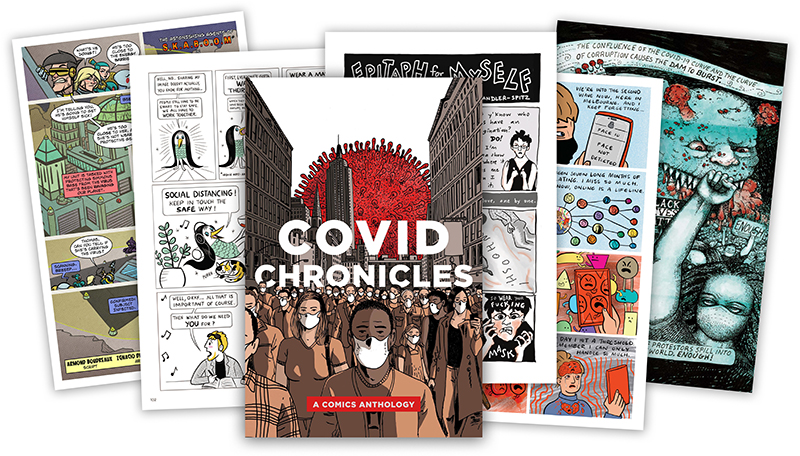The Comics of COVID | Stellar Panels
From graphical COVID diaries to investigative journalism, these comics are a time capsule of the pandemic experience.

Very little was clear in March 2020, when the COVID-19 pandemic began, but one thing was certain: We would be living through a historic event, something that people would be reading about long after it passed out of living memory. Many creators responded by looking for a way to record what was happening.
Some kept diary comics of life under lockdown, reflecting on the abrupt, dramatic changes in daily life at the beginning of the pandemic, the ways they adjusted to life in isolation, and the longer-term lessons they learned from the disruption and loss that ensued. Science educators explained how the virus is transmitted and how to stop that transmission, in short, often humorous, online cartoons. And journalists interviewed people who had experienced every aspect of the pandemic, from treating the sick to organizing the public response to dealing with their own loss and grief.
As the pandemic wore on, others used comics as the medium for their investigative journalism, detailing how and why the federal government’s response to the pandemic went so wrong.
 Journalists like to say that they are writing the first draft of history. Some of these comics reflect that, and in fact, you can often tell when a comic was made from the issues being depicted: The difficulty of getting a COVID test in the early days, shortages of masks and other personal protective equipment, the question of whether it’s necessary to sanitize the groceries. Given the time required to produce a book, none of the printed works currently available reflect the widespread release of vaccines.
Journalists like to say that they are writing the first draft of history. Some of these comics reflect that, and in fact, you can often tell when a comic was made from the issues being depicted: The difficulty of getting a COVID test in the early days, shortages of masks and other personal protective equipment, the question of whether it’s necessary to sanitize the groceries. Given the time required to produce a book, none of the printed works currently available reflect the widespread release of vaccines.
Our lives are different now, perhaps not as different as we would like. But already, we can look at the earlier comics and realize how much has changed. Taken together, these works are a time capsule of the pandemic years, one that will continue to grow even as the memories begin to fade.
Recommended reading
Covid Chronicles: A Comics Anthology. By Kendra Boileau and Rich Johnson. Graphic Mundi – PSU Press. July 2021. ISBN: 9780271090146.
Gr 8 Up—This book collects 64 short comics covering a wide variety of topics and experiences, starting with Jason Chatfield’s visual diary about living through the virus, and going on to short meditations on the social and personal changes wrought by isolation, the anxiety and anger that comes with it, and historical topics such as the iron lung.
Covid Chronicles. By Ethan Sacks. illus. by Dalibor Talajic. Upshot. December 2020. ISBN: 9781953165053.
Gr 11 Up—The 10 stories in this comics anthology are nonfiction, personal accounts of people who had different points of view on the pandemic, including researchers who found that the virus was already circulating in Washington early in the pandemic, a respiratory therapist who caught the disease, a journalist, and a nurse who was a “street medic” at demonstrations. The people profiled in the book are diverse, and Talajic’s artwork knits it all together visually. In the foreword, actress Alyssa Milano writes about her own experience with COVID and how it has haunted her, and in an afterword, Sacks explains how the comic was put together, including photos of some of the people profiled.
Digital comics
The most comprehensive starting point for COVID-19 comics is the COVID-19 page on the Graphic Medicine website, which lists comics on a variety of different COVID-related topics, including educational comics, ones by and about patients and caregivers, and comics that tackle issues of ethics and social justice. Except for the first online comic listed below, these selections are most suited for readers 13 and up because of the themes and the vocabulary.
A tale of two pandemics: A nonfiction comic about historical racial health disparities, by Josh Neufeld (The Journalist’s Resource, November 2020)
Neufeld cites recent research about the 1918 influenza pandemic to debunk the myth that Black people are less likely to die from COVID (or any other disease) than white people. He looks at the origin of the myth and historical counterexamples and discusses how Black leaders can help dispel misinformation about the current pandemic.
Diary Comic by Fifi Martinez (Twitter, August 2020)
Martinez was an essential worker during the pandemic, and this very brief comic shows how unnerved she was by customers who refused to wear their masks properly—a very common occurrence for those dealing with the public in stores and restaurants.
Having a Vaccine for Coronavirus, by Sheila Hollins and Lucy Bergonzi (Beyond Words, 2021)
This wordless comic shows a woman and a man learning about the vaccine; discussing it with each other; and, in the woman’s case, her doctor’s office; getting the shot; and enjoying being together afterward. The comic includes a suggested storyline and discussion prompts. Since it’s a UK-based comic, there are also resources for those in the UK.
How a Religious Cult in Korea Spread COVID-19, by Ryan Estrada and Kim Hyun Sook (The Nib, March 2020)
Estrada and Sook, the creators of the graphic novel Banned Book Club, look at one superspreader event linked to a cult-like church in South Korea, some of whose members not only refused to follow public health measures, but actively undermined them.
Just for Kids: A Comic Explaining the New Coronavirus: Malaka Gharib (NPR, February 2020)
Gharib, the creator of the graphic memoir I Was Their American Dream, explains the basics in a casually drawn comic with a reassuring tone. The comic can be printed and folded to make a zine, and translations are available in a number of different languages. More short comics can be found under the Coronavirus, Illustrated tag at the NPR website.
Meet the New Strains, by Maki Naro and Diana Kwon (The Nib, February 2021)
Naro and Kwon explain how mutations arise and what effect they may have on the virus itself and on the progression of the pandemic. The art is a mix of straightforward science illustrations and funny takes that help readers understand the biology a little better. This work mentions several different mutations, but was created before the current terminology was adopted, so there is no mention of the Delta and Omicron variants.
Pandemic Diaries, by Katy Doughty (Katy Doughty, March-June 2020)
Doughty, who is studying for her Masters in Public Health at Boston University, captures the strangeness of the early days of the pandemic in a series of short comics about everyday life.
Pandemix is a digital-only anthology edited by Dean Haspiel and Whitney Matheson and available as a PDF from the website of The Hero Initiative for a $5 donation. (The Hero Initiative provides help for comics creators dealing with illness and other issues.) The comics in the collection are mostly meditations on the the changes in everyday life and the overall sense of uncertainty that came at the beginning of the pandemic.
Supply Chain Superhero, by Josh Neufeld (Josh Neufeld Comix & Stories, July 2020)
Neufeld follows his brother Jake, the Enterprise Resiliency Manager of Memorial Sloan Kettering Cancer Center hospital, as he deals with shortages of PPE and deliberates whether to bring in refrigerated trucks to hold bodies.
Totally Under Control, by Josh Adams and Anthony Del Col (The Insider, September 2020)
This comic follows the evolution of the pandemic in the United States and South Korea and shows how the U.S. government botched the initial response. This is a good example of narrative journalism, using time stamps and other visual cues, such as a group of people with the infected individuals colored bright red, to get the point across. The creators list their sources at the end of the comic.

RELATED
The Adventures of Invisible Boy
King Cheer
Freshman Year
Continental Drifter
The job outlook in 2030: Librarians will be in demand
The job outlook in 2030: Librarians will be in demand
ALREADY A SUBSCRIBER? LOG IN
We are currently offering this content for free. Sign up now to activate your personal profile, where you can save articles for future viewing





Add Comment :-
Be the first reader to comment.
Comment Policy:
Comment should not be empty !!!